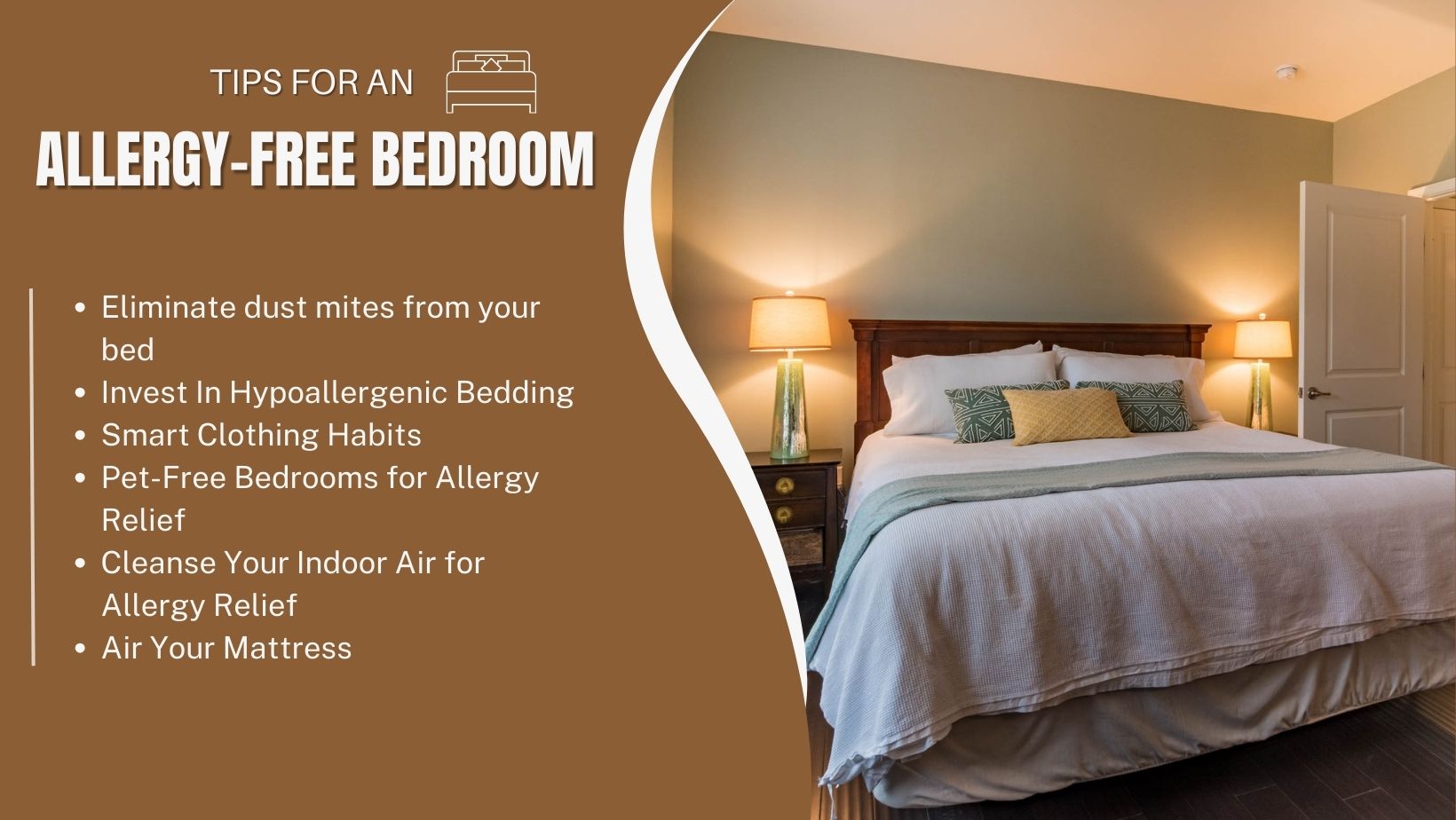Ensuring an allergy-free bedroom is of utmost importance for individuals grappling with allergies or asthma. Your bedroom is meant to serve as a tranquil retreat, a place where you can unwind and revitalise. However, when it’s plagued by allergens, it can quickly transform into a wellspring of discomfort and potential health complications. With the ebb and flow of seasons, a considerable portion of the global population finds itself locked in the annual combat against allergies. During these transitions, your bedroom often becomes an arena where allergy sufferers face an uphill battle, particularly on those balmy nights. Our comprehensive guide offers a wealth of time-tested strategies, making it easier than ever to combat allergies triggered by common culprits such as dust, pollen, and other irritants.
Enhancing Your Allergy-Free Bedroom Routine:
Maintaining an allergy-free bedroom involves diligent cleaning practices and climate control. If you have pets or carpets, vacuum your bedroom floor weekly to combat dust mites. These microscopic creatures often find refuge in carpets, but regular vacuuming can help eliminate them. Remember to wear a mask to prevent inhaling dust particles during the process. During warmer seasons, the temptation to open your bedroom windows for fresh air can be substantial. However, this may invite pollen inside, settling into your carpet or other areas. To prevent potential allergic reactions, it’s advisable to keep the windows closed. Additionally, consider complementing your strategy with the thickest tog duvet, ensuring a cosy and allergen-free sleep sanctuary, no matter the season.
Eliminate Dust Mites from your Bed:
Banishing dust mites from your bed is crucial if you’re constantly battling sneezing and discomfort at night. While it might seem like an allergy to your bed sheets, the real culprits could be these microscopic pests hiding within your linens. Dust mites can exacerbate allergies and asthma, disrupting your sleep. The good news is that eliminating them is a manageable task. Regularly wash your bed sheets, duvet cover, and pillowcases in hot water and tumble dry them at a high temperature. For added protection, invest in dust mite-proof bedding and covers for pillows, sheets, and your duvet. These barriers deter these nuisances from making your bed their breeding ground, ensuring a more restful and allergen-free sleep environment.
Invest In Hypoallergenic Bedding:
Opt for hypoallergenic bedding, like Tencel or bamboo, to combat allergies and asthma. These materials create an unfriendly environment for dust mites and germs. Tencel, sourced sustainably from eucalyptus trees, is known for breathability and antibacterial properties. Regularly wash your bedding to maintain cleanliness. Additionally, choose hypoallergenic blankets, duvet covers, and pillowcases made from bamboo or eucalyptus silk to repel mites, mould, and dust while providing a comfortable sleep experience. Consider a naturally antimicrobial latex mattress for added protection against dust mites.
Smart Clothing Habits:
Seasonal allergies, like hay fever, are triggered by pollen, which we inadvertently transport into our homes on our hair, shoes, and clothing after spending time outdoors. To create an allergy-free bedroom, adopt practical clothing habits. Keep a dedicated laundry basket outside the bedroom to prevent pollen-contaminated clothes from entering. Moreover, never wear outdoor shoes in the bedroom, as they can track not only pollen but also various outdoor allergens. These simple habits can help you maintain a clean and allergen-free sleep environment.
Pet-Free Bedrooms for Allergy Relief:
While our furry companions offer affection, they can bring unwanted allergens into our bedrooms. Pet dander, saliva, and even accidents can be sources of discomfort for allergy sufferers. To maintain an allergy-free bedroom, your pets should sleep in their designated spaces. If that’s not possible, take measures to minimise dander, such as frequent vacuuming and grooming your pets regularly. By keeping your bedroom a pet-free zone or managing allergens effectively, you can enjoy a more peaceful and allergy-free sleep environment.
Cleanse Your Indoor Air for Allergy Relief:
Improving your indoor air quality can significantly contribute to an allergy-free bedroom. Remember to replace the filter every few months as per the label instructions. Additionally, keeping your AC unit in “fan” mode circulates air, preventing pollen and other allergens from lingering indoors. By incorporating air filtration into your bedroom, you can create a cleaner, allergen-free environment, promoting restful nights and healthier living.
Air Your Mattress:
Over time, your mattress can become a breeding ground for allergens like dust mites and particles, particularly in hard-to-reach areas along walls or underneath. To maintain an allergy-free bedroom, consider employing a protective mattress cover, typically made of plastic, which encases the entire mattress. Periodically, take your mattress and pillows outside to air them out. Allowing fresh air and sunlight to penetrate these sleep essentials can help reduce allergen buildup. This simple practice enhances the cleanliness and hygiene of your bedding, ensuring a more restful and allergen-free sleep environment.
Creating an allergy-free bedroom is a crucial step in managing allergies and ensuring a good night’s sleep. By following these 10 tips, you can significantly reduce allergens in your bedroom, making it a safe and comfortable environment for relaxation. Remember that consistency in maintenance and cleanliness is key to keeping allergens at bay in your bedroom, ultimately improving your overall quality of life. Visit reviews auction or more interesting articles.
